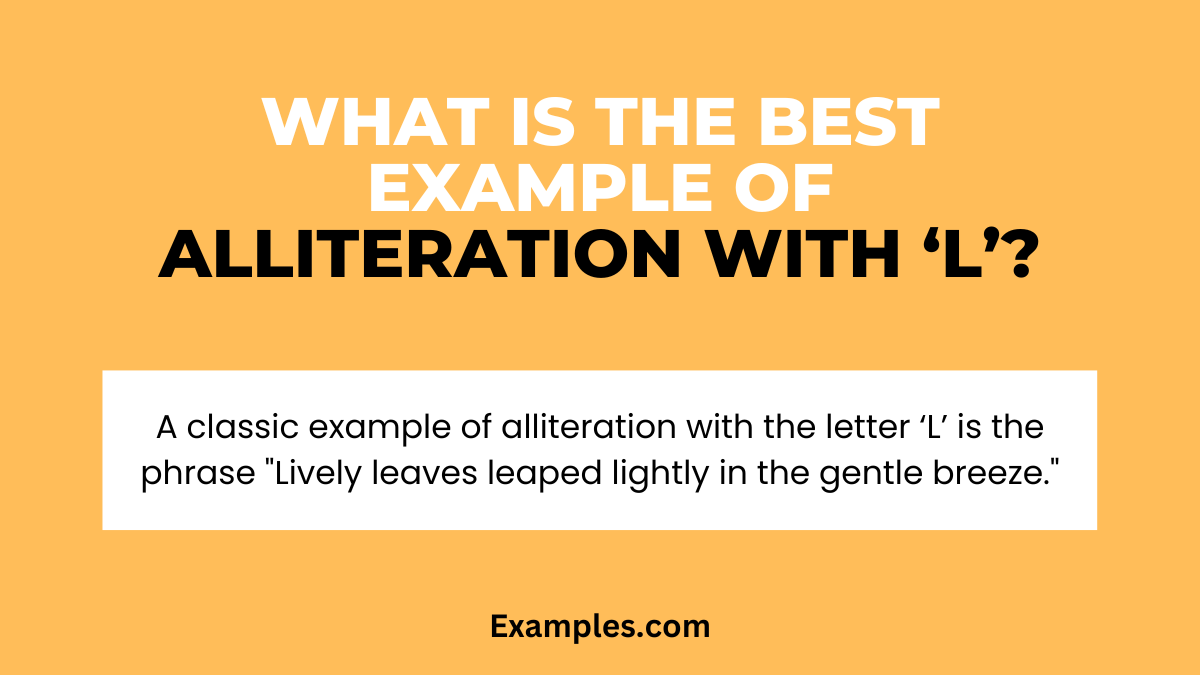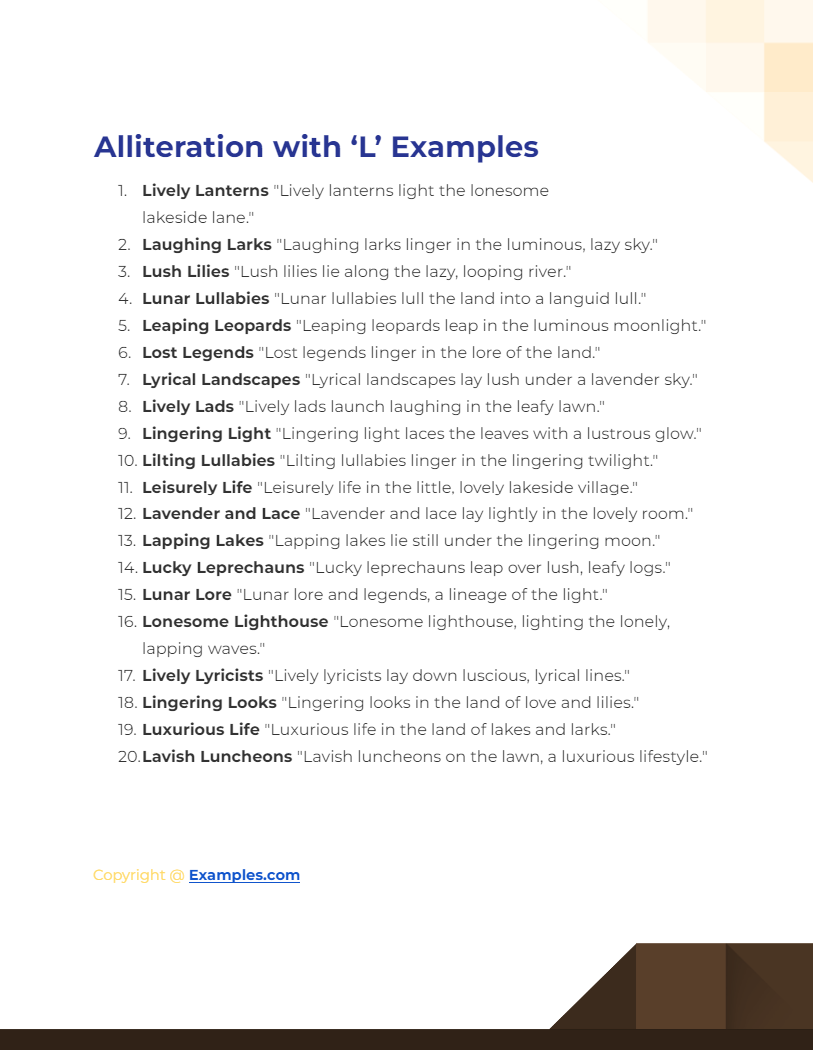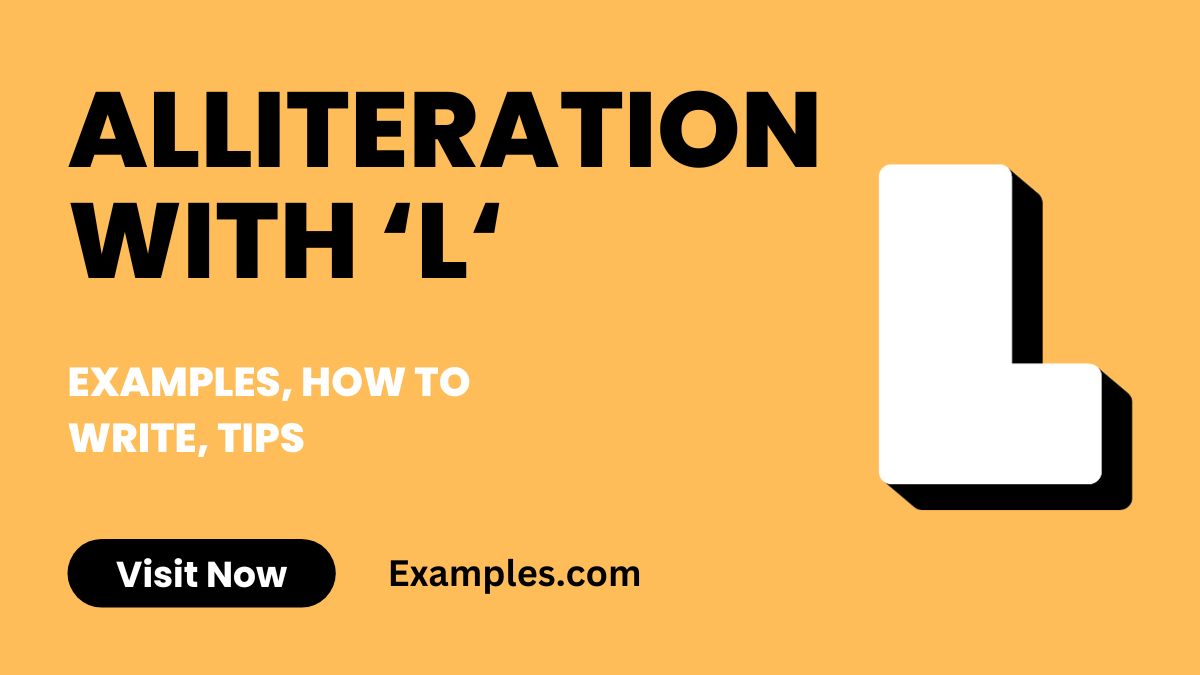19+ Alliteration with L Examples
Alliteration, the repetition of initial consonant sounds in adjacent or closely connected words, can create a mesmerizing effect in both written and spoken language. When it comes to the letter ‘L’, this literary device adds a lyrical and often soothing quality to phrases. For instance, consider the alliterative charm in “lovely lilies lay along the lake.” This simple yet evocative use of alliteration not only enriches the text’s auditory appeal but also strengthens its imagery and emotional impact. Crafting such alliterative literature phrases involves selecting words that share the ‘L’ sound, weaving them into coherent, impactful sentences that enhance the overall narrative or poetic rhythm.
Download Alliteration with 'L' Examples
Download Alliteration with 'A' to 'Z' Examples
What is the Best Example of Alliteration with ‘L’?

Example: A classic example of alliteration with the letter ‘L’ is the phrase “Lively leaves leaped lightly in the gentle breeze.”
Meaning: Alliteration is a literary device that involves the repetition of the same initial consonant sound in a series of words within a sentence or phrase. In the example “Lively leaves leaped lightly in the gentle breeze,” the consonant ‘L’ is repeated at the beginning of multiple words, creating a rhythmic and harmonious sound pattern. This technique is often used in literature and poetry to add musicality and emphasis to the text. In this specific example, the easy alliteration repeated ‘L’ sound evokes a sense of movement and grace, painting a vivid picture of leaves dancing in a gentle breeze.
20 Alliteration with ‘L’ Examples

Download Alliteration with 'L' Examples in PDF
Alliteration with the letter ‘L’ lends a lyrical and often lilting quality to language. The ‘L’ sound, known for its softness and fluidity, presents a wealth of opportunities for both easy and hard alliteration examples. This type of alliteration is especially effective in alliteration in rhymes, where the repetition of the ‘L’ sound can create a harmonious and engaging rhythm. Here are 20 unique examples of alliteration with ‘L’, each accompanied by a rhyme title that encapsulates the essence of the phrase.
- Lively Lanterns “Lively lanterns light the lonesome lakeside lane.”
- Laughing Larks “Laughing larks linger in the luminous, lazy sky.”
- Lush Lilies “Lush lilies lie along the lazy, looping river.”
- Lunar Lullabies “Lunar lullabies lull the land into a languid lull.”
- Leaping Leopards “Leaping leopards leap in the luminous moonlight.”
- Lost Legends “Lost legends linger in the lore of the land.”
- Lyrical Landscapes “Lyrical landscapes lay lush under a lavender sky.”
- Lively Lads “Lively lads launch laughing in the leafy lawn.”
- Lingering Light “Lingering light laces the leaves with a lustrous glow.”
- Lilting Lullabies “Lilting lullabies linger in the lingering twilight.”
- Leisurely Life “Leisurely life in the little, lovely lakeside village.”
- Lavender and Lace “Lavender and lace lay lightly in the lovely room.”
- Lapping Lakes “Lapping lakes lie still under the lingering moon.”
- Lucky Leprechauns “Lucky leprechauns leap over lush, leafy logs.”
- Lunar Lore “Lunar lore and legends, a lineage of the light.”
- Lonesome Lighthouse “Lonesome lighthouse, lighting the lonely, lapping waves.”
- Lively Lyricists “Lively lyricists lay down luscious, lyrical lines.”
- Lingering Looks “Lingering looks in the land of love and lilies.”
- Luxurious Life “Luxurious life in the land of lakes and larks.”
- Lavish Luncheons “Lavish luncheons on the lawn, a luxurious lifestyle.”
Alliteration Sentence Examples with ‘L’
Alliteration sentence examples with ‘L’ often evoke a sense of fluidity and grace, utilizing the soft ‘L’ sound to create rhythm and melody in the text. Such alliteration is frequently used in various forms of literary and artistic expressions, including alliteration in poems, songs, and movies, adding a lyrical or dramatic quality. Here are three examples:
- “Luna’s laughter lit up the languid, lazy afternoon.”
- “Lyle’s large, leafy plants lined the long, luminous hallway.”
- “Linda’s lovely lullabies lulled little Leo to sleep.”
Alliteration Examples with ‘L’ Words
Alliteration examples using ‘L’ words showcase the versatility of this consonant in creating memorable, flowing phrases. This form of alliteration is often used for its poetic quality in alliteration in poems and songs. Here are three examples:
- “Lush lavender fields lay under the lofty, luminous sky.”
- “Liam’s lively labrador leaped over the luscious lawn.”
- “Lucy’s little lanterns lit the labyrinthine lanes.”
Alliteration Examples with ‘L’ Sound
The ‘L’ sound in alliteration songs can produce a variety of effects, from gentle and soothing to vivid and lively. These examples show how the ‘L’ sound can be utilized in alliterative structures to create engaging and rhythmic sentences. Here are three examples:
- “Lopsided lilies languished in the lingering sunlight.”
- “Loud laughter echoed through the lofty, leaf-covered arbor.”
- “Legend of the lost lagoon lured many a curious soul.”
Alliteration Examples with ‘L’ Name
Incorporating names that start with ‘L’ in alliteration adds a personal and often endearing touch to the phrases, enhancing their relatability and impact. Here are three examples:
- “Laura’s lovely laces lay lightly on the lilac linen.”
- “Leo’s legendary lore left listeners longing for more.”
- “Lena’s lavish lifestyle was the talk of the lavish city.”
Alliteration Beginning with ‘L’
Alliteration beginning with ‘L’ sets a specific tone and rhythm in a phrase, often creating a memorable and aesthetically pleasing effect. This type of alliteration can be found in various artistic expressions, including alliteration in movies, where it adds a harmonious element. Here are three examples:
- “Lively larks leaped from limb to limb in the lush forest.”
- “Lamenting the lost love, Lila looked longingly at the lake.”
- “Lighthearted and lovely, Laura’s laughter lit the room.”
How to Write Alliteration with ‘L’?
Writing alliteration with the letter ‘L’ involves creating phrases or sentences where the ‘L’ sound is repeated at the beginning of closely connected words. This type of alliteration is known for its smooth, lyrical quality and can be used effectively in various contexts, from poetic compositions to educational materials like alliteration for first grade. Here’s how to create effective alliteration with ‘L’:
- Understand the ‘L’ Sound: Familiarize yourself with the ‘L’ sound, which is soft and fluid. It’s a versatile sound that can be used in both light and more serious contexts.
- Select a Theme: Choose a theme or subject. This helps in finding ‘L’ words that are relevant and coherent with your topic, important for creating alliteration with answers or for teaching purposes.
- Brainstorm ‘L’ Words: List words beginning with the ‘L’ sound. Include a variety of words (nouns, verbs, adjectives) to add depth to your alliteration.
- Construct Your Phrase or Sentence: Arrange the ‘L’ words to form a coherent and rhythmic sentence. Aim for a natural flow that emphasizes the alliterative effect.
- Read Aloud for Rhythm: The effectiveness of alliteration is best judged audibly. Read your sentence aloud to ensure it flows well and the ‘L’ sound is pronounced clearly.
- Revise for Clarity and Impact: Ensure your alliterative phrase is clear and contributes to your overall message. It should enhance the text, not complicate it.
- Apply in Various Contexts: Whether it’s in alliteration figurative language exercises, as famous alliteration examples, or in educational settings like alliteration for first grade, adapt your use of ‘L’ alliteration to suit the purpose and audience.
Tips for Using Alliteration with ‘L’
Here are the Tips for Using Alliteration with ‘L’:
- Use in Moderation: Alliteration should enhance your writing, not dominate it. Use it to emphasize key points or add stylistic flair.
- Maintain Clarity: Your primary goal is to convey a message clearly. Alliteration should complement, not confuse, your narrative.
- Vary Word Length and Complexity: Mix short and long ‘L’ words, as well as simple and complex words, for a more dynamic textual rhythm. This is particularly important in alliteration for first grade, where simpler language is necessary.
- Match the Mood: The ‘L’ sound is often associated with a soft, soothing quality. Use it in contexts where this mood is appropriate.
- Read and Revise: Reading your work aloud helps you assess the rhythm and flow. Adjust as needed to ensure the alliteration enhances the text.
- Suitable for Audience: Tailor your alliteration to your audience. For instance, alliteration for first grade should be simpler and more playful than alliteration for adults.
- Explore Different Forms: Try ‘L’ alliteration in various forms of writing, from poetry and stories to advertising and academic work, to understand its effect.
Remember, the key to effective alliteration with ‘L’ is balancing creativity with readability, ensuring that the alliterative phrases add value to your writing.
What are the Alliteration with ‘L’ for Kids?
Alliteration with ‘L’ for kids involves creating phrases or sentences where the ‘L’ sound is repeated in a way that is engaging and easy for children to understand and enjoy. This approach is excellent for language development, helping kids with phonetic awareness, and making learning fun. Alliteration for kids typically includes playful, simple, and rhythmic words. Great alliteration examples for kids include:
- “Larry the lazy lion lounges by the lovely lake.”
- “Lily’s little lamb leaped lightly in the lush meadow.”
- “Lucas loves licking luscious lemon lollipops.”
These examples are designed to be catchy and memorable, aiding in language development and literacy skills among children.
What is the Effect of ‘L’ Letter in Alliteration?
The effect of the ‘L’ letter in alliteration is to create a soft, fluid sound that adds a lyrical and sometimes soothing quality to a phrase. The ‘L’ sound is gentle and can be used to convey a sense of calmness, tranquility, or playfulness. In literature, ‘L’ alliteration is often used for its musical quality, adding rhythm and enhancing the auditory experience of a piece. This effect is evident in great alliteration examples across various forms of literature, including alliteration in poems and prose. The ‘L’ sound is versatile and can be effectively used in alliteration for students, and adults, depending on the context and the words chosen.
What is the Alliteration ‘L’ Type of?
Alliteration with the letter ‘L’ is a type of consonantal alliteration, where the consonant sound at the beginning of adjacent or closely connected words is repeated. Despite being a consonant, the ‘L’ sound often has a softer and more melodic quality compared to other consonants. This type of alliteration is popular in various forms of writing, from creative poetry to effective prose. It’s a favorite in educational materials for its appeal and effectiveness, widely used in alliteration for students and alliteration for kids. The ‘L’ type of alliteration can be used to create different effects, from whimsical and light (common in alliteration for kids) to more profound and impactful (often used in alliteration and assonance), depending on the context and the chosen words.


